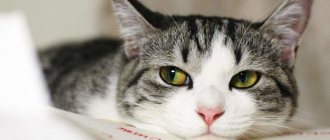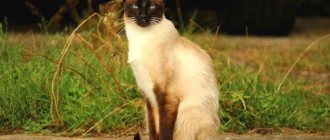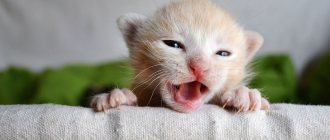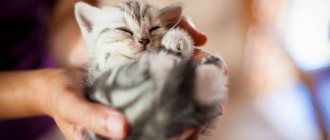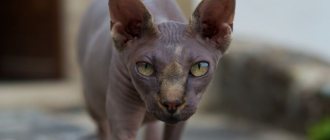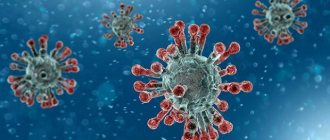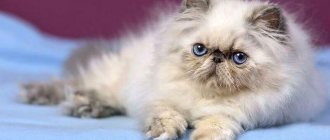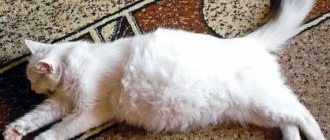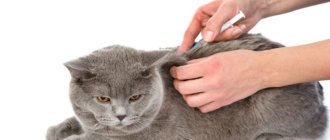Life cycle of mustachioed pets
The entire life cycle can be divided into 6 stages. Please note that they are all very conditional. Many cats remain playful and active even in their old age.
Infancy (up to 1 month)
Until 1 month, the kitten is completely dependent on the mother. In the first days after birth, he is blind and toothless, so communication with the outside world is very limited.
Childhood (up to 7-8 months)
With the appearance of the first baby teeth, the kitten begins to show more independence. He tries his first complementary foods and is actively learning new things.
At 2.5-4 months, the baby finally leaves his mother and learns to live independently. His molars gradually grow and puberty begins. By 7-8 months, female cats are already in their first heat, but they are still babies until their third heat.
Youth (up to 2 years)
At 1-1.5 years old males and female cats reach their first mating. They give birth to and raise their first offspring.
Youth (up to 4-5 years)
At this stage, breeders are actively breeding the breed. By age 5, most animals are removed for health reasons.
Maturity (up to 8 years)
The first behavioral changes appear. The cat becomes calmer and more reserved. She goes on crazy runs around the house less often, but still doesn't give up on games.
Old age (8-9 years and older)
At the final stage, there is a gradual attenuation of activity, an increase in sleep duration and the appearance of dental problems. The general well-being of the animal depends on the state of health.
In the absence of chronic diseases, significant changes are not observed. An elderly pet can be picky about food and show its devotion to its owner more clearly through affection and increased attention.
Record-breaking cats for life expectancy
Among all the rules there is always an exception. Such exceptions sometimes include cats, whose life length goes beyond the limits provided by nature. Such centenarians are included in the Guinness Book of Records. First place was unconditionally taken by the oldest cat named Puff: 38 years of cat life. There lived a cat grandmother in Texas.
global $ads_google; //data-ad-slot=”2475549904″ $ads_google = empty($ads_google) ? false : true; ?> if ($ads_google == false) {?>
$ads_google = true; ?> } ?>
Also interesting is the cat, who was born at the beginning of the 20th century, in 1903, and lived happily in the southwest of England for 36 years. He died the next day after his last birthday.
Several more cats were among the record holders; one feline was 30 years old, the other was 23. Today, the longest-living cat among the meowing cats lives in Melbourne, Australia, and goes by the name Catalina. The Burmese beauty began her life in the 20th century and is 35 years old this year.
So the formula for long life for cats consists of the following set of factors: a loving owner plus health care plus the qualities of the breed.
What determines the lifespan of cats?
The lifespan of cats depends on a number of external and internal factors. Some contribute to its increase, while others contribute to its reduction.
What promotes longevity
Anything that has a beneficial effect on health is responsible for longevity. These include:
- balanced diet;
- timely vaccination, deworming and treatment against external parasites;
- absence of hormonal surges;
- safe maintenance to prevent injury;
- Regular visits to the veterinarian for preventive purposes.
All of the above are completely inaccessible to street cats. For this reason, they always die earlier than domestic ones.
What shortens years of life
Factors that reduce immunity and undermine health have the opposite effect. These include:
- living in unfavorable conditions (frequent temperature changes, dampness, unsanitary conditions);
- lack of regular nutrition, consumption of low-quality foods and lack of vitamins;
- genetic predisposition to certain pathologies;
- frequent pregnancies and childbirths;
- infection;
- free range, fraught with injury or death under the wheels of vehicles;
- frequent and prolonged stress;
- excess weight, which provokes problems with the musculoskeletal system and hormonal disorders.
All of the above can significantly reduce the allotted years by more than 2 times.
Factors influencing the life expectancy of cats and kittens
The length of a cat's life span is influenced by various factors, including heredity, proper care, and others.
Heredity
Health, energy, ability to reproduce, and negative character traits can be inherited. The genes inherited by an animal from its ancestors can in some way influence its lifespan. When an animal has good genes and good health from its parents, it has a better chance of living a long life. Before choosing a pet, it is a good idea to find out its pedigree, if any.
A cat's good heredity increases its chance of a long life
This step will help you find out how long the cat can live, how long it will be active, and what possible diseases it inherited.
You need to know that cat breeds bred to participate in exhibitions and competitions do not live long. Their structure and the entire body as a whole will be negatively affected by the influence of selection. These changes are passed on to each next generation.
Proper care
The life span of cats is also greatly influenced by proper care for them. It includes:
- nutritious nutrition: the popular phrase “We are what we eat” can also be applied to animals, since a cat by nature is a predator, it needs high-quality animal proteins, a varied food and a nutritious diet with the addition of essential vitamins and microelements will contribute to the normal development and vitality of the body; You should not overfeed your cat - obesity reduces life expectancy;
Proper care will make a cat long-lived
- systematic examination at a veterinary clinic, timely adoption of preventive measures, vaccination: regular visits to the doctor will help to identify and prevent a dangerous disease in time;
- physical activity of the pet to maintain its shape: it is necessary to create conditions for the cat to play, his active lifestyle, it is necessary to play with the animal more often;
- hygiene in caring for the animal: you need to ensure proper care of the fur, claws, teeth; hygiene procedures help improve the health of the pet;
- care and attention towards the pet.
Sex life
The longevity of cats also depends on such an important factor as sex life. Street cats can experience up to 3 heat cycles in a year, ending in birth.
Street cats are promiscuous
Their reproduction occurs faster and more often than in domestic animals that have difficulty with sexual activity. Cats living at home produce a lot of hormones that complicate the birth procedure; therefore, the birth of indoor cats is more difficult than that of their street counterparts. It is worth noting that mating a domestic cat or a cat with stray animals can cause a serious illness in the pet.
Sterilization and castration
Domestic cats and cats that have retained their genitals live less than those that are spayed or neutered. Uncontrolled pregnancies often occur in cats, which can worsen the health of the animals.
The cat Dusty in America gave birth to 420 kittens during her life. She holds the record for the number of babies born.
Complications that arise in a cat during pregnancy and childbirth affect its lifespan.
Therefore, animal owners who sterilize their four-legged pets are concerned about prolonging their life. And those, in turn, not having the ability to reproduce, will additionally be protected from stress, hormonal surges, and infection with infectious diseases acquired through sexual intercourse from sick males or females.
Presence of diseases
The owner of the cat may not notice the changes that have appeared in its condition. Regular visits to the veterinarian should be present in the animal's life. Periodic examinations will help to promptly identify the development of diseases, tumors, benign and malignant, in the animal. Cats at a fairly mature age are more susceptible to them. Their vision and hearing also deteriorate.
In old age, it becomes difficult for an animal to move and resist the attacks of younger relatives. Aging pets, who are kept primarily indoors, are protected from the dangers that may arise when free-ranging.
With increasing age, chronic diseases of the joints and skeleton occur in the body of older animals. Such changes should prompt owners of aging animals to reconsider their care.
Habitat
Where a pet lives has a big impact on how long it will live. Indoor cats have better capabilities that allow them to live longer than their outdoor counterparts. The average number of years of life of a cat, regardless of breed, is from 10 to 15 years. Cats living in the yard or on the street have a life expectancy of 5–6 years less than the average; they generally live from 6 to 8 years. Their lifespan depends on:
- lack of food, hunger;
- weather conditions: rain, frost, cold;
- the presence of parasites, viral diseases;
- physical injuries;
- food and chemical poisoning;
- frequent appearance of offspring;
- other dangers associated with transport, other animals, people.
Stray cats placed in indoor conditions can live much longer than is prescribed by street standards.
Outdoor cats live longer when brought into a home environment
It’s much worse for pets who end up on the street. Their chances of leading a wandering life even for a year are very small, since they are not used to searching for food and defending themselves. The gender of animals does not affect how long they live.
How many years do street cats live?
Approximately 85% of animals born on the streets die as kittens. This occurs due to weakened immunity, low temperatures, infections, parasites and poisoning. Stronger individuals usually live up to 4-8 years.
The worst situation is for domestic cats that are lost or abandoned by their owners. Being unadapted to such harsh conditions, they die from stress, cold and hunger within the first 3 years.
How long does a cat live on average without water?
The health and life of a pet in absence depend on several factors:
- The colder it is outside, the more likely your pet is to survive until moisture appears. If an animal is left without water in a hot summer, its body will be dried out literally within a day.
- Diet. If a cat eats only dry food, then its moisture reserves must be replenished regularly. If there is a lack of water with such a diet, the body will not last long. If the animal eats wet food, then the water should last for a long time. However, if the owner is leaving for a long time, he should ask friends to come to the pet and feed and water it at least once a day.
- It is believed that British Fold cats do not drink water due to the nature of the breed. However, some British owners note that their pets drink water like other animals.
- The older the pet, the more water it needs every day. A cat can drink about 250 ml of water per day. How long will cats last at home in the absence of moisture? Without serious health consequences – about 2 days. Then comes severe exhaustion and disruption in all body systems. In total, the animal can live without fluid for about 5 days. Sometimes death occurs earlier.
Life expectancy of cat breeds at home
Longevity directly depends on the breed. Most artificially bred breeds are characterized by hereditary diseases that reduce the number of years allotted. This explains why the average age of mongrel cats that have escaped human intervention is often 5 years older.
Average and maximum indicators: table
The average and maximum age indicators characteristic of purebred animals can be found in the example table. It presents the 10 most popular representatives of the cat family.
| Breed name | Lifespan | |
| Average | Maximum | |
| Siamese | 15 | 20 |
| Scottish | 15 | 20 |
| Russian blue | 14 | 19 |
| Bengal | 13 | 16 |
| Maine Coon | 12,5 | 16,5 |
| Persian | 10-17 | 20 |
| British | 12 | 16 |
| Siberian | 15 | 20 |
| Abyssinian | 12-15 | 20 |
| Sphinx | 13 | 14 |
Most of these breeds do not live to their maximum age due to chronic renal failure, urolithiasis, polycystic kidney disease and cardiovascular pathologies.
Long-lived breeds
Long-livers include all representatives of the Siamese-Oriental group, Maine Coons, Siberians and other aboriginal breeds. All of them were able to avoid direct human intervention in their long history of development and went through the most reliable selection - natural selection. Thanks to him, Aboriginal cats received strong immunity and good health.
Life of a street and indoor cat
Life expectancy is affected by habitat. Well-groomed and caressed domestic cats live much longer than their street counterparts. The latter have to survive, get food, and hide from the cold in winter. In the cold, death from hypothermia overtakes animals quite quickly.
Kittens born in the basement or on the street die in the first months of life in 90% of cases. The reason for this is weakened immunity, lack of heat and viral diseases. Only the strongest survive, but they have yet to prove their strength in street fights. It is not surprising that they have a short life span - few live up to 7 years, and a 10-year-old street cat will be considered a long-liver.
Animals that end up outside from home find themselves in even worse conditions. Most often, the owners refuse them, indifferently throwing them away like an unnecessary rag. The chances of living at least a year on the street for cats unadapted to such conditions are negligible.
The life of a pet is a different matter. There is good food in the bowl, a warm bed in the room. Vitamins and vaccinations protect against diseases; at the slightest deviation, a caring owner will take all measures to restore the pet’s health.
How castration or sterilization affects longevity
Contrary to popular belief, surgery to deprive reproductive function does not shorten, but prolongs the life of your pet. This happens thanks to:
- softening of character (the cat stops getting into fights and looking for adventures);
- prevention of oncology and sexually transmitted diseases;
- absence of hormonal surges due to medications, pregnancy and childbirth.
Frequent birth and feeding of kittens greatly wears out the body. He suffers not only physically, but also emotionally. After sterilization, this problem completely disappears, as does the possibility of developing cancer. Thanks to the operation, the overall life expectancy is increased by 3 years.
The only disadvantage for castrated animals is their tendency to become obese. Due to a slower metabolism, they gain weight faster, so their diet must be strictly controlled.
Cat years into human years
Question, calculating the age of a kitten is not a task of elementary mathematics. A common misconception is that one "cat year" is approximately equal to seven "human years", meaning that a one-year-old cat is equivalent to a 7-year-old child, and a 5-year-old cat is equivalent to a 35-year-old adult.
In fact, cats age differently than humans.
- Although there is no scientific formula for calculating the rate of aging in relation to humans, it is generally accepted that the first two years of a cat's life are equivalent to the first 25 years of a human's life.
- After this time, cats age approximately four times faster than humans. This means that after the age of two, one of our years is roughly equivalent to four “cat years.”
Ways to help prolong the life of a pet
If your cat is approaching her final stage, don't despair. After all, for many, life after 8 years is just beginning. By following a number of recommendations, this period can be extended as long as possible.
Proper nutrition
Don't skimp on the quality of your products. Buy meat, vegetables and dairy products in trusted places or choose ready-made food of at least premium quality.
Be sure to follow the feeding schedule, avoiding overfeeding and handouts from the table. Remember that on a natural diet you must add vitamins prescribed by your veterinarian to your food.
Competent care
Avoid the formation of tangles and strong darkening of tooth enamel. Brush your pet 1-2 times a week and brush his teeth every month.
Also remember to keep your eyes and ears clean. Remove any secretions that accumulate in them and be sure to contact a veterinarian if an unpleasant odor or foreign matter appears.
Pay special attention to physical activity. Monitor your cat's weight and don't let him nap on the couch too often. Outdoor games improve health, promoting longevity.
Vaccinations and disease prevention
Most infections can be prevented through vaccination. The first vaccination followed by revaccination is given when the child reaches 2 months of age. With the onset of the year, the frequency of grafting reaches no more than 1 time per year.
In addition to viruses and bacteria, you should be wary of parasites and genetic pathologies. To prevent them, it is necessary to promptly treat with anthelmintic and acaricidal drugs and undergo an annual preventive examination at a veterinary clinic.
No stress
The family situation plays a big role. The absence of quarrels between owners and a reverent attitude towards the pet have a positive effect on mental health.
Sexual health
When participating in breeding, all rules must be strictly followed. Do not attempt to start your breeding career early or exceed the recommended birth rate. Bearing offspring is always accompanied by severe nervous tension and hormonal changes, so timely retirement is very important here. Otherwise, the animal risks not living to its allotted time.
If breeding and selling kittens is not part of your plans, sign up your pet for castration immediately after puberty. This will protect her from cancer and other dangerous complications associated with hormones. A similar choice should be made regarding the cat.
Requirements for the place of detention
Pets should be kept in a warm and clean environment. Locate the sleeping area away from drafts and prohibit your pet from sleeping on a tiled floor. To avoid hypothermia, be sure to accustom your cat to a bed or install an underground heating system.
Don't forget to change the litter in the tray, wash food bowls after each feeding and change the water daily. Remember that not only freshness is important, but also the absence of foreign impurities. Water must be purchased from a store or passed through a filter to remove any sediment it contains.
How to extend the life of a pet
Proper care, coupled with due attention from the owner towards the pet, will help increase the cat's life expectancy.
Owner's attention
Almost all pets become strongly attached to their owners. Cats are considered the most pampered pets, who prefer to receive signs of attention rather than bestow them on their neighbors. Owners should understand that a lack of affection can often ruin the purr’s psyche.
Common mistakes in keeping cats
Everyone wants their pussy to live with them for a long time, to delight their household with its presence, playfulness, and purring. But some pets get sick and die prematurely due to various mistakes of their owners.
Feeding on demand
Adults should be given cat food no more than 2 times a day. Too frequent feeding often provokes the development of obesity, which has a detrimental effect on the functioning of the heart. Veterinarians usually prescribe a special diet for an overfed cat that can normalize the purring body weight.
Walking without supervision
It is not permissible to let a domestic cat go outside without being accompanied by its owner and a leash. Otherwise, he will rummage through garbage cans and may eat the spoiled food there and become poisoned.
Also, the pet is not immune from fights with more aggressive relatives, and fights are often fraught with serious injuries.
Loneliness
There are many cases where cats greatly missed their owner, who had to leave the pet for a long time for one reason or another. These animals did not live long.
Don't leave your purrs! Don't hurt their psyche! This is especially true for owners of sterilized cats, as well as neutered cats.
Frequent bathing
Bathing is almost always stressful for purrs. For this reason, water procedures should be carried out only when necessary.
Long-haired pets, as well as hairless pussies, should be washed more often than usual. A dirty animal will have to be given a good bath. And naturally, the fluffy mustache will need to be “beautified” before the exhibition. In general, it is enough to bathe an ordinary pussy once every 6 months.
Canine behavior requirement
Owners should be aware that it is unacceptable to treat a cat like a dog. Even if she lives in the house together with a dog, and these two pets are friends with each other, you need to understand the difference in the psychology of these animals.
A dog is distinguished above all by devotion. She values rigor more than tenderness. A cat, on the contrary, is characterized by a love of freedom. She would not be able to sit on a chain all day, like a dog, and also sleep in a cold booth - this would be a terrible nervous shock for her.
The purr also needs more tenderness. For this reason, it is unacceptable to raise your voice at a cat, in order to avoid the development of stress in the animal.
Cat to human age ratio
The most popular method of converting a cat's age to a human age is 1 to 7. Despite this, it is the most unreliable. Instead, they are increasingly using a scheme with a slow growth rate. In it, 1 year is equated to 15 years, 2 years to 9, and each subsequent year to 4. That is, a one-year-old cat is a 15-year-old teenager, the same animal at the age of 2 is a 24-year-old independent man, and at 3 and 4 years, the age of the mustache is equated to 28 and 32 years, respectively.
Veterinarians usually adhere to the scheme from the international veterinary passport. According to him, the ratio is as follows:
| Cat age (years) | Human age (years) |
| 1 | 18 |
| 2 | 25 |
| 3 | 30 |
| 4 | 35 |
| 5 | 40 |
| 6 | 43 |
| 7 | 45 |
| 8 | 50 |
| 9 | 55 |
| 10 | 60 |
| 11 | 62 |
| 12 | 65 |
| 13 | 68 |
| 14 | 72 |
| 15 | 74 |
| 16 | 76 |
| 17 | 78 |
| 18 | 80 |
| 19 | 90 |
| 20 | 100 |
But here everything is very conditional. Maine Coons and Siberians have a very long adolescence, so at 4-5 years their psychological age is close to adolescence.
Long-lived cats
A cat's lifespan of 30 years can be compared to the 170 years of a human's life. Several long-lived cats and male cats have been registered:
- The white cat Blackie lives and leads a fairly full-fledged existence in the UK. In 2010, she became the record holder for longevity and lived for 25 years, outliving 3 of her litters. Its owner is of the opinion that the cat’s long life is due to his caring attitude towards the animal.
Blackie the cat outlived three of her offspring.
- Also in 2010, the Guinness Book of Records was replenished with two more long-lived cats. One of them is a cat, a resident of Texas, named Jake Perry Cream Puff, or “Cream Pie” (in translation). He lived 38 years. Another long-liver is a sphinx called Granpa Rex Allen. His life span was slightly shorter and amounted to just over 34 years. Granpa was famous, parties were held in his honor, at which time the cat treated himself to dishes of broccoli, bacon, and coffee. Many believed that such unusual taste preferences added years to his life.
Sphynx Granpa Rex Allen was popular and participated in parties in his honor
- Lucy from South Wales, an elderly lady who is over 40 years old, held the record for absolute longevity in the cat family in 2011. Lucy still feels well today. She, practically deaf, is now on duty to protect the house from mice.
- Spike lived in England for thirty years. At the age of 19, he had an unsuccessful fight with a dog and had throat surgery. Contrary to the disappointing forecasts of doctors, the cat remained alive and overcame the average life expectancy barrier. Maybe the local climate and good nutrition helped him in this.
- The Burmese cat, named Lady Catalina, has reached the age of 37 years.
- There are long-living cats in Russia too. One of them is Prokhor, who is now 28 years old.
Love and proper care of animals allowed them to live so long.
Determining the age of a kitten or adult cat
It is impossible to determine the exact age of an animal taken from the street, but an approximate age is not at all difficult. Veterinarians determine it by external signs: the condition of the teeth, fur, mustache, eyes and musculoskeletal system.
The older the cat, the more worn out his teeth are. Very old individuals may lack incisors and fangs. Also, with aging, dulling and thinning of the coat is noted. By the age of 10, the first gray hair appears, spreading from the fur coat even to the mustache. The animal's eyes become dull and the spine begins to sag. The gait loses its former confidence, and the claws lose flexibility.
Long-lived cats
Among the representatives of the cat family there are long-livers. It is obvious that in the fate of these lucky girls everything worked out in the best way: excellent heredity, good care, balanced nutrition, attention and a kind, caring attitude of the owner.
Thus, the longest-living cat is listed in the Guinness Book of Records. Her name is Cream Puff. The record holder lived for 38 years and three days. The owner of the animal is an American from Texas. There are long-livers in the UK, as well as other European countries. For example, the British cat Lucy. She is already 43 years old. By human standards - about 175 years. Lucy lives in the UK. Until now, the cat leads an active lifestyle. The only thing is that she can no longer hear anything. In Australia there lives a Burmese cat named Lady Catalina. She is now 37 years old. The cat is active and healthy.
In our country, unfortunately, long-lived cats have not yet been registered. And there are several reasons for this. Firstly, the content is not particularly correct. Secondly, they have a less friendly disposition than, for example, the British, who are very kind to animals. Thirdly, there is no cult of records in the country. Therefore, not everyone is in a hurry to report the long-lived cat to the administration of the Guinness Book of Records.
How long a domestic cat lives depends on many factors: genetics, breed, general health, proper nutrition and care.
On average, representatives of the cat family live 12-17 years. Sterilized individuals last 3-4 years longer. To increase these averages, it is extremely important to love and protect your pet. Attention, care and love - this is what a cat needs for longevity.
What affects life expectancy
- Habitat. As we have already found out, this is the most important factor that affects the lifespan of an animal.
- Breed of cats and cats, selection.
- Nutrition, feed quality.
- Diseases and infections.
- Frequent childbirth.
- Sterilization and castration.
- Vaccination, vaccinations.
- Incorrect crossing (consanguineous relationships).
- Injuries and falls.
- Excess weight.
- Gender of the animal.
- Poisoning.
- Self-walking.
At home, from the first days in the house, it is necessary to observe the cat, identify bad habits and immediately wean them off. For example, kittens are curious from childhood and can eat litter, which is very harmful to health and clogs the intestines. Also, both kittens and adult cats can chew wires, which is very life-threatening.
Determining the age of a cat
If you adopted a cat from a shelter or picked it up on the street, then you probably want to know the cat's age. Your veterinarian will help you determine the age of your cat with an accuracy of up to a month. The doctor will look at the cat's teeth - if it has milk teeth, then it is a kitten and is about 1 year old. If the teeth are white, this is a young cat; in older cats and cats, the teeth become covered with plaque and begin to wear off.
You can determine the age of a cat by its whiskers - after 9 years of life, a cat’s whiskers begin to turn gray. A person can determine how old a cat is just by eye, but a veterinarian can do several tests and determine the age more accurately.
